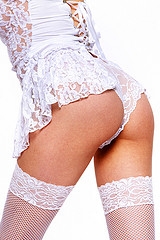
Lingerie, From Depravity to Fashion Necessity
Lingerie– the word suggests lacey, titillating garments. But lingerie came from humble origins. The term “lingerie” is from the French linge, or linen alluding to the cloth from which underwear was by tradition made. By the end of the nineteenth century, lingerie had become a common term to describe underwear that had moved beyond sensible functions to be used as a device of for the exhibit of the female body. Lingerie was initially made for every size- including plus sizes.
However, caution was advocated at first: Lingerie should only be used by women within the confines of a happily married life. “. . . . dainty undergarments are not necessarily a sign of depravity” wrote one female fashion journalist in 1902. However, as the twentieth century progressed, the increase in the popularity and use of lingerie mirrored women’s gradual freedom from the constraints of Victorian morality and notions of what constituted appropriate as they emerged as more socially independent beings. Lingerie was a departure from the rationalist and unashamedly moralistic undergarments advocated by the Victorian standards. For instance, one expert espoused the use of wool as the perfect underwear for reasons of hygiene and health.
In the beginning, handmade lingerie was a symbol of high social class, which only a few could afford. Notable were those designed by English fashion designer known as Lucile (Lady Duff-Gordon) who produced camisoles, peignoirs, and petticoats using combinations of lace, chiffon, and crepe de chine. These fabrics intentionally appealed to the sense of touch, and were the basis of a new sensuality for the 20th woman. Although artificial fibers such as rayon and nylon were marketed in the 1920s and 1930s as a luxury fabrics through the use of the name “artificial silk” their use made lingerie more affordable.
WIKIPEDIA SAYS-Nylon is a thermoplastic silky material, first used commercially in a nylon-bristled toothbrush (1938), followed more famously by women’s “nylons” stockings (1940). It is made of repeating units linked by peptide bonds (another name for amide bonds) and is frequently referred to as polyamide (PA). Nylon was the first commercially successful polymer and the first synthetic fiber to be made entirely from coal, water and air.
The more body-conscious fashions of that decade also led to a new item of lingerie, the teddy, named after its inventor Theodore Baer, who combined a chemise with a short slip or attached panties. The camisole, originally derived from a decorative waist-length garment with an embroidered front and shoulder bands that were worn over the corset for warmth and modesty, became a essential piece of lingerie, later transforming into an item of outerwear by the 1970s. Similarly the slip, a standard piece of lingerie from the 1950s was used by a number of fashion designers as outerwear in the 1990s, most notably John Galliano, Dolce & Gabbana.
Pajamas, based on the loose pants worn in parts of Asia, entered women’s wardrobes in the late nineteenth century, but long nightdresses remained popular, even after women’s skirts shortened in the early twentieth century. By the1920s, straight-cut silk and rayon nightclothes in subtle colors such as orchid, teal and plum were popular, while the mid-century favored gowns with bosom-hugging bodices above sinuous skirts. Mixtures and superimpositions make lingerie an item of clothing in itself, so that hybrid costumes like chemise jackets and pants-skirts make up an unexpected wardrobe. During the twentieth century, alluring and luxurious lingerie grew ever more accessible and affordable.
Today there is a continuance of the lingerie revitalization started in the 1990s, with both male and female consumers. Lingerie’s status as an appealing, emphatically visible component of a woman’s outfit has kept sales on an upward trend. It seems that visible lingerie has become a strong style. Redefined lingerie is a reasonably priced luxury item with a powerful appeal for the style conscious plus size consumer.
About the Author
For more plus size fashion with flair visit http://www.fabulous-plus-sizes.com/Site_Map.html, a trendy plus size clothing website.
How To Pick Lingerie That Complements Your Body Type